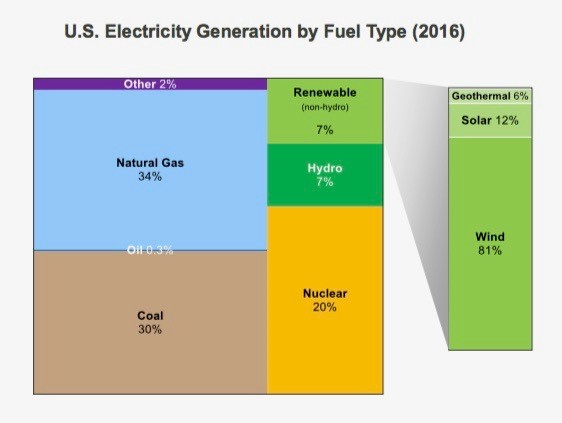A new report released this week finds that increased use of natural gas for power generation has played a huge role in dramatically reducing U.S. carbon dioxide, sulfur dioxide, nitrogen oxide and mercury emissions. If this sounds familiar, it’s probably because EID has reported on numerous reputable reports over the years that have reached similar conclusion.
But what makes “Benchmarking Air Emissions of the 100 Largest Electric Power Producers in the United States” stand out is the fact that it is spearheaded by Ceres and co-sponsored by the Natural Resources Defense Council (NRDC) — both well-known anti-fracking groups.
Nonetheless, the report is again refreshingly forthcoming in crediting natural gas for 24 percent carbon reductions from the nation’s top 100 electricity producers from 2005 levels in 2016, as well as 91 and 82 percent reductions in sulfur dioxide (SO2) and nitrogen oxide (NOx) emissions, respectively, since 2005, and 86 percent reductions in mercury emissions since 2000. From the report:
“Some of the factors driving this trend include energy efficiency improvements and the displacement of coal by natural gas and renewable energy resources.”
As the following chart from the report shows, these trends have occurred at the same time that U.S. gross domestic product (GDP) has increased steadily since 2009.

The report notes that, “The data points to a decoupling of economic growth and carbon emissions; from 2005 to 2017, electric sector CO2 emissions decreased 24 percent while GDP grew 20 percent.” As EID has noted before, this is a historic and unprecedented trend.
The report also notes that natural gas became the top fuel source for electricity generation in 2016, accounting for 34 percent of the total generation mix.

Not coincidentally, the report’s data shows that power sector carbon emissions fell another four percent from 2005 levels from 2015 to 2016, while SO2 and NOx saw a year-over-year decline of another four and three percent, respectively, from 2005 levels, while mercury emissions plummeted another 13 percent from 2000 levels from 2015 to 2016.
These declines can be explained by the fact that natural gas emits far less mercury, NOx and CO2 when combusted than other traditional fuels, while its SO2 emissions are virtually non-existent. The increase in solar and wind generation since 2005 can also be partially credited to natural gas. Because wind and solar are intermittent sources of energy, they need natural gas for backup, and have become more viable due to abundant and cheap natural gas made possible by the shale revolution. Collectively, the transition to more natural gas and renewable use has netted huge emissions reductions. As the report notes:
“In 2016, the U.S. electric system continued its general shift away from coal toward lower-and zero-emitting sources. For the first time, natural gas (34 percent) overtook coal (30 percent) as the largest source of electricity in the U.S. This marks a shift away from higher-emitting power sources compared to a decade ago (2006), when coal and natural gas accounted for 49 percent and 20 percent of power production, respectively.”
EID reported earlier this year that natural gas use for electricity generation has increased 81 percent since 2005, and reputable third parties such as the Energy Information Administration, International Energy Agency (IEA) and Intergovernmental Panel on Climate Change agree this is a huge reason why U.S. power sector carbon emissions decreased to their lowest levels since 1988. The EIA has credited roughly two-thirds of energy-related U.S. carbon reductions since 2005 to natural gas.
As EID highlights in its “Compendium of Studies Demonstrating the Safety and Health Benefits of Fracking,” the SO2, NOx and mercury emission reductions detailed in this report are important considering power plants have traditionally been the top sources of these criteria pollutants, which EPA has said “can harm your health and the environment.”
The Ceres report acknowledges:
“Power plant emissions of other air pollutants such as sulfur dioxides (SO2), nitrogen oxides (NOx) and mercury (Hg) also continued to decline.”
“The electric power sector has made significant progress in terms of reducing its NOx and SO2 emissions. From 2000 through 2017, NOx and SO2 emissions decreased 79 and 88 percent, respectively.”
A recent IEA report finds that poor air quality kills approximately 6.5 million people a year, making it the fourth highest cause of death in the world. The IEA also recently noted that increased natural gas use helps reduce the three most dangerous pollutants contributing to these staggering figures — SO2, NOx and PM2.5:
“The edge of natural gas over other combustible fuels is reinforced when considering emissions of the main air pollutants, including fine particulate matter (PM2.5), sulfur oxides, mainly sulfur dioxide (SO2), and nitrogen oxides (NOX). These three pollutants are responsible for the most widespread impacts of air pollution…”
The EPA has previously said that SO2 is “of greatest concern” with regard to health, due in large part to the fact that it combines with other pollutants to form fine particulate matter (PM2.5), which is literally killing millions in the developing world.
NOx is most widely known as a major precursor to ground level ozone formation. As EPA states:
“Oxides of nitrogen react with volatile organic compounds to form ozone and react with ammonia and other compounds to form particle pollution resulting in associated public health and environmental effects. Deposition of nitrogen oxides contributes to the acidification and nutrient enrichment (eutrophication, nitrogen saturation) of soils and surface waters. These effects can change the diversity of ecosystems.”
Notably, the most recent EPA data show that the two primary ozone precursors — nitrogen oxide (NOx) and volatile organic compounds (VOC) — have decreased 49 and 15 percent respectively since 2005, while fine particulate matter emissions have declined 32 percent. That same data show ozone concentrations have decreased 22 percent during that timespan.
In other words — increased natural gas use is dramatically improving U.S. air quality. And this Ceres/NRDC-led report is among the most compelling testaments to that fact.